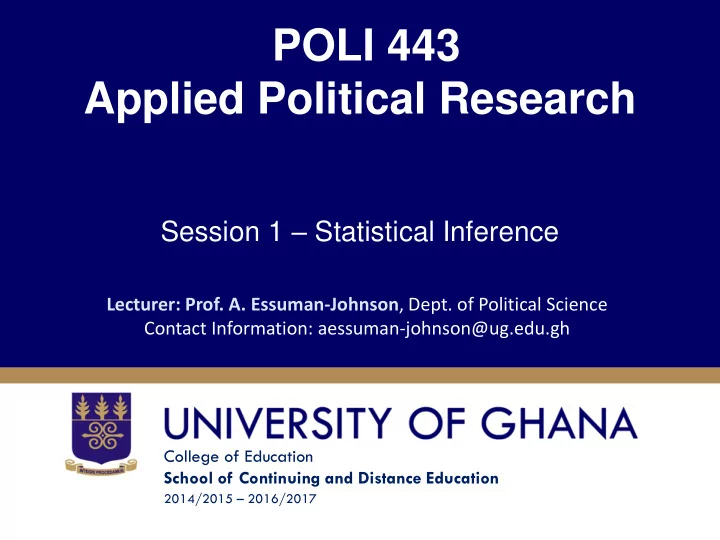

POLI 443 Applied Political Research Session 1 – Statistical Inference Lecturer: Prof. A. Essuman-Johnson , Dept. of Political Science Contact Information: aessuman-johnson@ug.edu.gh College of Education School of Continuing and Distance Education 2014/2015 – 2016/2017
Introduction Assume we are to decide if a coin is fair i.e. if the probability of a head is 0.50. This is to be decided through the repeated simple experiment of tossing the coin. If the coin is fair then in an infinite number of tosses of the coin, the relative frequency of heads must occur with the probability of exactly 0.50. For example, the coin is tossed 4 times and says 4 heads occur. This will raise no special doubt upon the fairness of the coin since it is relatively likely that the relative frequency of heads will depart widely from 0.50 on such a small number of trails (tosses). Slide 2
• However, if after 500 tosses of the coin, the number of heads were 500, we would begin to have serious doubt about the fairness of the coin though this could happen. If for example we toss the coin 5 million times and have 100% heads we could be practically certain that the probability of a head for the coin is not 0.50 .This example exhibits one of the basic features of statistical inference as applied to many real problems. We start with a theoretical state of affairs that can be represented by a statement of the probability for one or more events. Slide 3
• We use empirical evidence to check the truth of that theoretical situation. An experiment is conducted. The theoretical probabilities tell us what to expect with regard to the relative frequencies of the event in question and compares the obtained frequency against those expected. Based on this evidence, a conclusion is reached and the theory is verified or rejected. However, we can never be completely sure in our judgment that the theory is false unless an infinite number of observations are made. Slide 4
This session introduces you to statistical inference which is the study of a sample and drawing relevant conclusions about the population from the information gathered from the sample. The session will cover the following topics: The Normal Distribution Forms of the Normal Distribution Curve Objectives By the end of this session, you should be able to understand the characteristics of the normal distribution and understand the forms of the normal distribution curve. Slide 5
The Normal Distribution Introduction The concept of normal distribution derives from the mathematical concept of binomial distribution. This is based on the assumption that that there is a probability of an equal chance for things to happen or not to happen. The normal distribution is a very important kind of frequency distribution. It is useful not only because a large number of empirical distributions are found to be approximately normal but also because of its theoretical significance in inductive statistics. Slide 6
• Normal distributions are generated whenever the phenomenon in question e.g. Height, weight etc is produced by a large number of chance or probability factors that themselves are not highly integrated. Probability is the mechanism used to make inferences about the population based on information contained in a sample. In probability we commence with a known population and deduce the outcome of a sample. But statisticians reason in reverse. Slide 7
• By knowing the details of a sample and the probability of occurrence for various populations the statistician deduces the nature of the population. To be able to infer, we need to have knowledge of the probability distribution for the random variable measured in the experiment. It is also frequently assumed that errors like those of measurement are normally distributed. Slide 8
The Normal Curve • Fig. 1 Slide 9
Fig. 2 Since it is symmetrical and uni-modal, its mean median and mode all coincide. However not all symmetrical bell-shaped curves are normal. Slide 10
The curves in Fig. 3 differ with respect to peakness due to the differences in their standard deviations. The most important properties of Forms of the Normal Curve ). Fig 3 • The curves in Fig. 3 differ with respect to their peakness due to the differences in their standard deviations. The most important properties of the normal curve are as follows: (a) It is bell-shaped (b) It is symmetrical about its mean (c) The location and spread of the normal distribution will depend on the values of the population mean (µ) and population standard deviation ( ). Slide 11
THANK YOU Slide 12
Recommend
More recommend